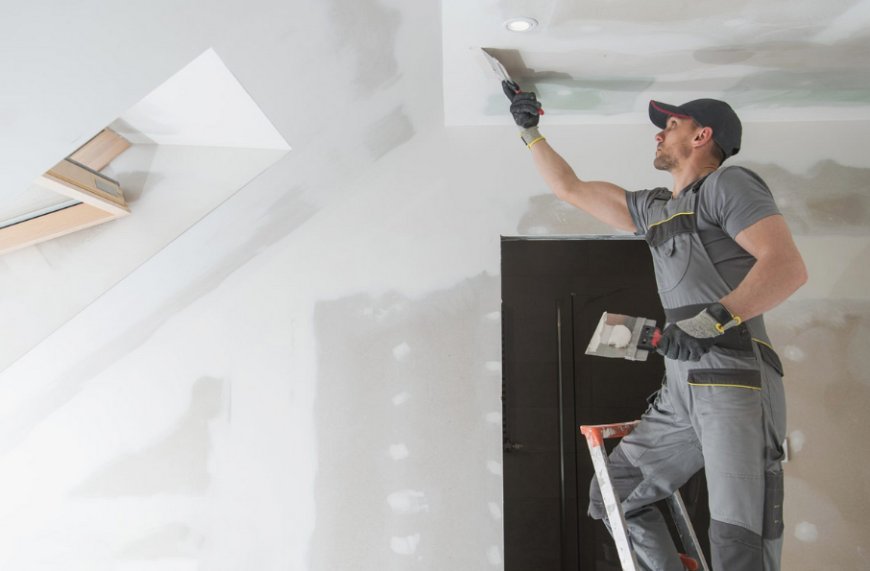How to Paint Over Drywall the Right Way: A Simple Guide
Painting over drywall? Follow these easy steps to prime, prep, and paint your walls for a beautiful, long-lasting finish.

Have you ever wondered whats behind the paint on your walls? That smooth, clean surface you see in nearly every home or office is likely drywall. Its one of the most widely used building materials, yet many people dont realize how essential it is to everyday construction. Whether you're remodeling a room or building from scratch, understanding drywall can help you make better, more informed decisions.
This guide will walk you through what drywall is, how its used, its types, and how to handle it properly. Whether you're a homeowner, contractor, or DIY enthusiast, this blog is your go-to source for drywall basics.
What is Drywall and Why Is It Important?
Drywall is a construction material made from compressed gypsum (a natural mineral) placed between two layers of heavy paper. Its used to form the surfaces of interior walls and ceilings. Its popularity comes from being lightweight, easy to install, and more affordable than traditional plastering methods.
In modern construction, drywall offers a quick and reliable solution for creating smooth, paint-ready surfaces. It plays a major role in both residential and commercial buildings, giving structures a finished look while helping with insulation and fire resistance.
Where is Drywall Used?
Drywall can be found in nearly every interior space. Its favored for its versatility and adaptability. Heres where youre most likely to encounter it:
-
Living Rooms and Bedrooms Used for clean, seamless wall and ceiling finishes.
-
Basements With moisture-resistant variants, drywall is ideal for finishing basement walls.
-
Commercial Offices Quick to install and perfect for dividing workspaces.
-
Apartments and Condos Easy to replace or repair, making it great for property managers.
No matter the project, drywall provides a strong and smooth foundation for your interior design.
Different Types of Drywall Materials
Theres more than just one kind of drywall. Depending on your space and needs, different types offer unique features. Here are the most common ones:
1. Standard Drywall
Also known as white board, this is the most basic type and is used in most dry areas of a home or office.
2. Green Board (Moisture-Resistant)
Designed for damp environments like kitchens, bathrooms, or laundry rooms. It resists moisture better than standard drywall but is not waterproof.
3. Blue Board (Plaster Baseboard)
Used mainly for veneer plastering. It absorbs plaster easily and is great for high-end finishes.
4. Fire-Rated Drywall (Type X)
Thicker and denser, it slows the spread of fire and is often used in garages, stairwells, and between apartment units.
5. Soundproof Drywall
Heavier and layered with extra materials to reduce sound transferideal for bedrooms, home theaters, or offices.
Choosing the right type of drywall ensures your space is safe, quiet, and durable for years to come.
Benefits of Using Drywall in Construction
Drywall is more than just a blank surfaceit comes with several key benefits:
-
Quick Installation: Compared to plaster, drywall can be installed in a fraction of the time.
-
Affordable: Its cost-effective and widely available.
-
Customizable: Easy to cut, shape, paint, and decorate.
-
Insulating Properties: Helps maintain room temperature and reduce noise.
-
Repair-Friendly: Cracks and dents can be fixed without replacing entire sections.
Because of these advantages, contractors and homeowners consistently rely on drywall to complete their interior projects efficiently.
Drywall Installation: How Its Done
Installing drywall may seem complex, but it's a step-by-step process that follows a clear pattern. Here's a simplified overview:
-
Measure and Cut Sheets: Match the drywall to your wall dimensions using a utility knife.
-
Screw into Wall Studs: Secure the sheets to the wooden or metal studs behind your walls.
-
Apply Tape and Mud: Use joint tape and compound (mud) to hide seams and screws.
-
Sand Smooth: Once the mud dries, sanding ensures a smooth surface.
-
Finish and Paint: After prep, the drywall is ready for paint or wallpaper.
Professionals can finish a room in a day or two, but with the right tools and patience, DIYers can also take on smaller drywall jobs successfully.
Drywall Repair Tips Every Homeowner Should Know
Damage to drywall is commonfrom small nail holes to larger cracks or water stains. Thankfully, it's one of the easiest materials to repair.
-
Small Holes: Use spackle or a patch kit to cover nail or screw holes.
-
Cracks: Apply joint compound and sand down once dry.
-
Water Damage: Remove and replace affected sections to prevent mold.
-
Dents: Fill with compound and repaint for a seamless fix.
Routine inspection and minor touch-ups will keep your drywall looking fresh and well-maintained.
FAQs
Q1: How thick is standard drywall?
A: Most commonly, its 1/2 inch thick. Ceilings may use 5/8 inch for added strength, while thinner sheets are available for curved walls.
Q2: Can I install drywall in a bathroom?
A: Yes, but use moisture-resistant or mold-resistant drywall like green board or purple board for extra protection.
Q3: Is drywall eco-friendly?
A: Many drywall products are made with recycled materials, and gypsum is a naturally occurring mineral. However, old or damaged drywall should be disposed of properly.
Q4: How do I know if my drywall has mold?
A: Musty odors, discoloration, and soft spots can be signs of mold. If you're unsure, a professional inspection is a good idea.
Q5: Can drywall be used on ceilings?
A: Absolutely. Drywall is commonly used for ceilings in both homes and commercial buildings and offers a clean, finished appearance.
Conclusion
Drywall may seem simple, but it plays a major role in shaping the spaces we live and work in. From walls and ceilings to soundproofing and fire safety, this humble material offers enormous value. Its flexibility, affordability, and ease of use make it a top choice for builders and renovators alike.







































